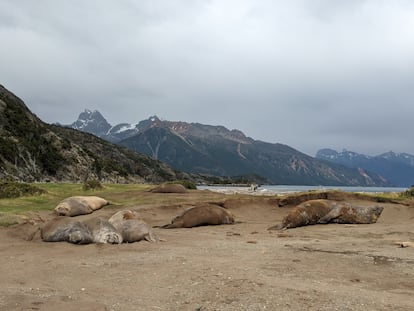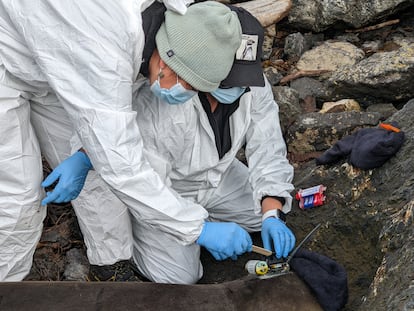Chilean scientists team up with southern elephant seals to explore the ends of the Earth
A group of researchers put satellite transmitters on six animals to capture information at a depth of 1,640 feet under the sea. They are seeking to gain a better understanding of both the water conditions and the species’ behavior

On January 23, a group of Chilean scientists and a British colleague crossed Tierra del Fuego through the Strait of Magellan to Caleta María, a small estate half an hour’s sail from Jackson Bay, in the far south of Chile. They arrived there looking for the country’s only large resident population of southern elephant seals (Mirounga leonina), which can number up to 160 individuals between October and November, the breeding months, according to the Wildlife Conservation Society.
After this period, the elephant seals shed their fur, along with the underlying layer of skin, and resume their journeys through the seas at the end of the world. “We needed to catch animals that had already molted but had not yet left,” says Maritza Sepúlveda, a marine ecologist at the University of Valparaíso, who is leading a project that uses these pinnipeds to explore and collect oceanic data in the far south.
To attach the satellite transmitters, the scientists had to make sure that the animals had already shed their fur so that it would not detach from their skin. The researchers chose some of these seals — three males and three females — and fitted them with the devices. Their goal is to capture data both from the ocean and from these marine mammals.
Elephant seals were chosen because they are great divers: they can dive as deep as 6,560 feet (2,000 meters), explains Manuel Castillo, an oceanographer at the University of Valparaiso. Each time the elephant seals surface, the device connects with the satellite, the data they’ve collected is triangulated, and the scientists can review it on a web page.

The researchers’ study measures the structure of these waters, which involves taking data at different depths. This was a “unique opportunity,” Castillo says. “It’s very difficult to do it the way we typically do. We usually go in a boat, carry our instruments and go down,” he says, describing the traditional method of exploration. But it’s a “very complicated logistical” feat, and it is also expensive and difficult, especially in the rugged southern channels and fjords.
“The elephant seal was ideal and already proven to have the ability to go deep and make multiple dives,” he notes. And unlike whales and dolphins, these marine animals then congregate in one place: “They move around, but then come back to a place where you can find them,” Castillo explains. “There are different ways to take advantage of technology with organisms in a passive way, without stressing them so much.”
The dirty work
Elephant seals rest on rocky beaches, laden with seaweed and trees that drift into the bay propelled by the current, while inland there are cold steppe grasslands. “Elephant seals are very calm there,” Sepúlveda observes. Amid strong winds, seagulls, cormorants, buff-necked ibis and solitary condors flying over the nearby hills, by an ice fall, the scientists chose which individual animals to anesthetize and fit with transmitters.
The dominant male elephant seals measure up to 16 feet (five meters) in length and are much larger than the females; that is uncommon in pinnipeds, which usually show little sexual dimorphism: “The other species are more monogamous, and the males do not have to compete with each other, so there’s not much difference between sexes,” explains the expert. She notes that “there is no other mammal” that has so many females — dozens of them — under its control. So, the larger males were not candidates for anesthesia. “The ones we did put transmitters on were not so big,” Sepúlveda says, adding that, since it wasn’t their breeding season, they were not as hostile.
The tide was another factor the scientists had to consider. If the tide was rising and the animal was half asleep, it was risky to execute the maneuver. They were alert. Veterinarian Josefina Gutiérrez calculated the dose to give based on their size, until they relaxed and were anesthetized. Once they were asleep, nasal and blood samples were taken for analysis. “Once we have the animals asleep, we have to get the juice out of them,” she says. After cleaning their skin with acetone, the transmitters were glued to their hair with a harmless substance for 10 minutes to keep them firmly attached, while the specialist monitored the sedated animal’s heartbeat and breathing.
Aware of the avian flu epidemic that has killed thousands of marine mammals in the south of the continent, the researchers followed a strict dress code. “The work was always done in pursuit of the seal’s welfare, which was the most important thing,” the ecologist remarks. “We didn’t have any problem with the animals.”
During their weeks of molting, elephant seals spend long hours lying down, while the young often go into the water to play among themselves by fighting and bumping their necks; they will also do that as adults, although more violently.

Another difficulty of anesthetizing pinnipeds is that when sedated they experience apnea, and, in the worst cases, they do not wake up. “You couldn’t work in the rain because it could stimulate the animal to go ‘diving,’” she explains. They had to be dry; there could not be more than a drizzle. “We had one animal who went into a three-minute apnea and then it breathed normally [again].”
Now, after returning to the water, the six elephant seals are expected to transmit data for eight to nine months. Among other factors, this will depend on the devices’ battery life; the deeper they go — about 328 feet (100 meters) and about 41°F (5°C) — the less time the charge will last.
Mysterious waters
“The Cape Horn current is little studied: basic oceanographic parameters such as changes in temperature, salinity and chlorophyll are almost unknown,” says Sepúlveda. With the advance of technology, they invested in these “live monitors” that, through their routine of moving and feeding, collect data like “3D oceanographic sensors.” In other words, “they are explorer seals,” she says of these divers that weigh a ton and have adapted to spend dozens of minutes submerged; for example, their blood can contain a lot of oxygen.
“When you go to the doctor, you feel sick and don’t know what’s wrong. The doctor says, ‘let’s do some tests,’ because that way they get data that they can compare with normal ranges to find out if there is a disease,” says Castillo. This is exactly what these researchers are looking for when they explore the ocean through the seals.
Some key data are water temperature and salinity at different depths and heights, from the surface to the bottom. They also collect information on the fluorescence or the “concentration of organisms that photosynthesize, or phytoplankton.” In addition, they take the pH and oxygen levels, which “is highly relevant [because] it gives an idea about the general state of health of the bodies of water,” he remarks. But while oceanographers study the sea, ecologists want to know about the divers themselves, where they go and how much they dive. “We’re doing two big investigations within one,” says Sepúlveda. “It’s quite original.”
The researchers are also looking to get more information about the area, known as the Almirantazgo Fjord, west of Isla Grande de Tierra del Fuego. They lowered an instrument called CTD (Conductivity, Temperature, Depth) almost to the bottom of the sea to make “profiles” of those sites and get new information that differs from what the National Oceanographic Committee, led by the Chilean Navy, has occasionally obtained from a ship.
According to Castillo, some preliminary data they have attained from this new project is that, because the glacier at the front is melting due to rising temperatures, the waters of the fjord — that is, the deep gulf between mountains — are low in salt. “It’s low in salinity,” he says, “but then deep down it regains salinity.” Researchers have also noticed a “large accumulation of chlorophyll” 33 feet (10 meters) below the surface: “It’s curious because organisms that photosynthesize typically like to be higher up but, in this case, they are lower down.” This is something that has “not been very well described,” despite it being “typical” of channels and fjords.
In recent weeks, some elephant seals have already left Jackson Bay and taken dives exceeding 1,640 feet (500 meters) deep. “The good thing is that they are already telling us that they are traveling, moving through the area that interests us and starting to connect the fluorometry, temperature and salinity data,” Sepúlveda says. The ecologist is also interested in knowing what their migrations are like, because “very little is known” about them... Will they return to the same place at the end of the year? She does not know, but she hopes so.
Sign up for our weekly newsletter to get more English-language news coverage from EL PAÍS USA Edition
Tu suscripción se está usando en otro dispositivo
¿Quieres añadir otro usuario a tu suscripción?
Si continúas leyendo en este dispositivo, no se podrá leer en el otro.
FlechaTu suscripción se está usando en otro dispositivo y solo puedes acceder a EL PAÍS desde un dispositivo a la vez.
Si quieres compartir tu cuenta, cambia tu suscripción a la modalidad Premium, así podrás añadir otro usuario. Cada uno accederá con su propia cuenta de email, lo que os permitirá personalizar vuestra experiencia en EL PAÍS.
¿Tienes una suscripción de empresa? Accede aquí para contratar más cuentas.
En el caso de no saber quién está usando tu cuenta, te recomendamos cambiar tu contraseña aquí.
Si decides continuar compartiendo tu cuenta, este mensaje se mostrará en tu dispositivo y en el de la otra persona que está usando tu cuenta de forma indefinida, afectando a tu experiencia de lectura. Puedes consultar aquí los términos y condiciones de la suscripción digital.
More information
Archived In
Últimas noticias
Most viewed
- Reinhard Genzel, Nobel laureate in physics: ‘One-minute videos will never give you the truth’
- Oona Chaplin: ‘I told James Cameron that I was living in a treehouse and starting a permaculture project with a friend’
- Pablo Escobar’s hippos: A serious environmental problem, 40 years on
- Why we lost the habit of sleeping in two segments and how that changed our sense of time
- The fall of a prolific science journal exposes the billion-dollar profits of scientific publishing










































